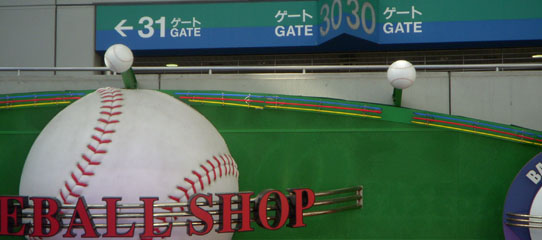What’s a Sox game without dried squid and beer?
TOKYO – Peanuts! Popcorn! Squid jerky, anyone?
The Boston Red Sox play their season opener nine days from now at the Tokyo Dome, once home field to their relief pitcher Hideki Okajima, a former member of the Yomiuri Giants. And instead of those sausage and onion subs on Yawkey Way, fans will be munching dried squid, soy beans, fried noodles, and sushi along with their burgers and corn dogs.
If anyone wants a beer, young women come around with backpack kegs and fill a cup for about 800 yen ($7.50). And there’s the organized cheering, replete with complicated clapping rhythms, chanting, and hand motions. Sox fans can start their own: “Gambare Reddo Sokkusu!” (Let’s Go, Red Sox!)
Shopping for Major League Baseball paraphernalia? On the main concourse is a rare place where Yankee and Red Sox gear is laid out side by side, as are posters of two of Japan’s current elites playing Stateside: Daisuke Matsuzaka and Hideki Matsui.
The stadium, part of the Tokyo Dome City entertainment complex, is anchored on one end by the Tokyo Dome Hotel and the other by a spa and multilevel outdoor shopping mall. From one end to the other there are family friendly restaurants and amusement park attractions. Thunder Dolphin, an erector-set-like roller coaster, slips its screaming passengers through a hole in one building before it descends precipitously and through another hole in the colossal “Big O” Ferris wheel. But it is not all “Fear Factor”-type rides. There are plenty of mini-thrills for young children, like whirling cups and a carousel.
The popular “takoyaki” – big round pancake balls stuffed with octopus and topped with seaweed shavings smothered in a savory sauce – are available at the shop Tsukiji Gin-daco. Visitors can snack while watching the Water Symphony, a shallow pool with a chorus line of water jets shooting high into the air synchronized to arias and Broadway tunes. On the sixth floor is one of Japan’s greatest natural resources, the “onsen” (natural hot spring), at Spa LaQua. Natural hot springs bubble up through the earth’s core right into the pipes of the indoor and outdoor shallow pools. Aches and pains can be kneaded out at one of the many massage venues.
At the end of the day, The Artist’s Cafe on the top floor of the Tokyo Dome Hotel is a great place for drinks. Here patrons sit on the stools at the floor-to-ceiling glass windows and look out over the capital sparkling all around them.
From that lofty height, with Tokyo’s glamour on display, one wouldn’t guess that there are areas nearby that still retain their old neighborhood flavor. Sugamo, just three subway stops from the Dome on the Mita Line, is a deeply urban section considered a fashion and lifestyle haven for seniors. Don’t be put off. This place, with its temples and bargain shopping, is interesting for any age.
Sugamo may be Japan’s capital of red wear. Red is an auspicious color in this country and the Japanese believe the center of a person’s well being resides in the stomach region. Protect and keep this area warm they say, and you will gain strength and happiness. So seniors flock to shops like Maruji, one of many along Jizo Street, for “akapantsu” (red undies), also fondly referred to as “power pants.” This is not Victoria’s Secret lingerie. It’s cotton over-the-belly wear and it’s available along with red belly warmers, red boxers, red long underwear, even red socks.
Health is serious business in Japan and Sugamo is usually crowded with shoppers and wellness seekers. Before the start of Jizo Street is the temple Shinseiji, site of one of the six largest jizo statues in Tokyo. (A jizo is a guardian saint in Buddhism.) With an umbrella-like hat fanning out over his 9-foot frame, this jizo sits atop a pedestal amid the smoke from lighted incense sticks. This is the place to pray for health.
Beyond the temple, through the arches, is the main shopping street, Jizo Dori. The aroma of roasting soy sauce wafts from a shop selling handmade rice crackers piled high in an old wooden display case. Inside patrons sit at the rear on one of the wooden benches surrounding a charcoal pit. There’s no charge for a warm cup of green tea.
Farther down the street is the gate of Koganji Temple, where the middle-aged and elderly come in droves to fix what ails them. On the temple grounds are stalls selling talismans, antiques, old kimonos, and even salted pickles. Inside the temple a priest chants above the steady beat of a drum. But the big attraction at Koganji is the statue of Kannon, a female saint who represents mercy and salvation. Families stand in a snaked line awaiting their moment with the saint. They carry white towels, available for purchase, to wash and dry the part of the body that ails them or a loved one. The cloth is then taken home to rub over the afflicted area.
The shops along Jizo Street are always bustling, but on the 4th, 14th, and 24th of each month the atmosphere is festive. That’s when outdoor stalls set up to sell food, roots, trinkets, spice, and herbal mixtures. At the spice stall buyers choose their own blend of black and white sesame seeds, shaved seaweed, and cayenne pepper. For souvenirs there are “daifuku,” sweets made from rice flour and bean jam, and sesame cookies with imprints of the jizos
Fuyusha stocks crafts made from Japanese fabrics: stuffed folk animals, mobiles, handbags, hair clips, and pocketbooks. There is no shortage of Japanese tchotchkes here – and none is terribly expensive.
With its good humor and boundless vitality, Sugamo never gets old.
Not far from Sugamo, at Nippori Station on the Yamanote rail line, is the more tranquil Yanaka, which escaped damage from the Kanto earthquake in 1923 and the fire bombs of World War II. The neighborhood has retained many of its old wooden structures, including the tile-roofed homes of merchants and more than 80 Buddhist temples. During cherry blossom season the next few weeks, Sakura Dori (Cherry Blossom Road), bordering the Yanaka Cemetery, becomes an arborway of pink.
Although the area has a vibrant main shopping street, Yanaka Ginza, it is the side streets that are the most fun. They are filled with small temples, antiques shops, folk crafts, and artisanal food. One shop sells handcrafted “tenugui” (handcloths) with folk designs another devoted to the manekki nekko (beckoning cat), its paw raised in welcome, is the theme for this shop, which has cute, expressive cats from floor to ceiling, most handmade.
The Asakura Choso Museum is closed on Monday and Friday. The exterior of the famous Japanese sculptor’s home is Art Deco modern, the interior traditional Japanese, with a beautiful garden.
Farther along is Space Oguraya, a gallery for visiting artists in what was once a storehouse for family treasures. Its museum is housed in a former pawnbroker’s old wooden shop. Takao Ito, the owner, displays his mother Toshi’s paintings of early-20th-century Tokyo. Her scenes from daily life between the world wars depict women and children sewing, folding origami, drying persimmons, and playing games. Ito sells colorful postcards of the paintings in the shop attached to the gallery.
On a street near Yanaka Ginza is Jomyoin Temple, famous for its 84,000 jizo stone statues stretched out row after row. Beyond the temple, shops along the narrow road sell traditional wooden sandals, fashionable clothing, bedding, and green tea. Most are on the ground floor of old wooden structures, some in better condition than others. The area is home to the distinctive architecture of old Tokyo. Here the aroma of grilled chicken attracts a crowd purchasing food to take home for dinner. Another group gathers around a shop known for its potato and meat croquettes.
At the end of the street are steep steps leading to Nippori Station. It’s a tough climb at the end of a long day wandering some of Tokyo’s old neighborhoods.
Debra Samuels, a freelance writer in Lexington, can be reached at debrasamuels@yahoo.com.












 Debra Samuels, bestselling author, food writer and cooking instructor,
Debra Samuels, bestselling author, food writer and cooking instructor,